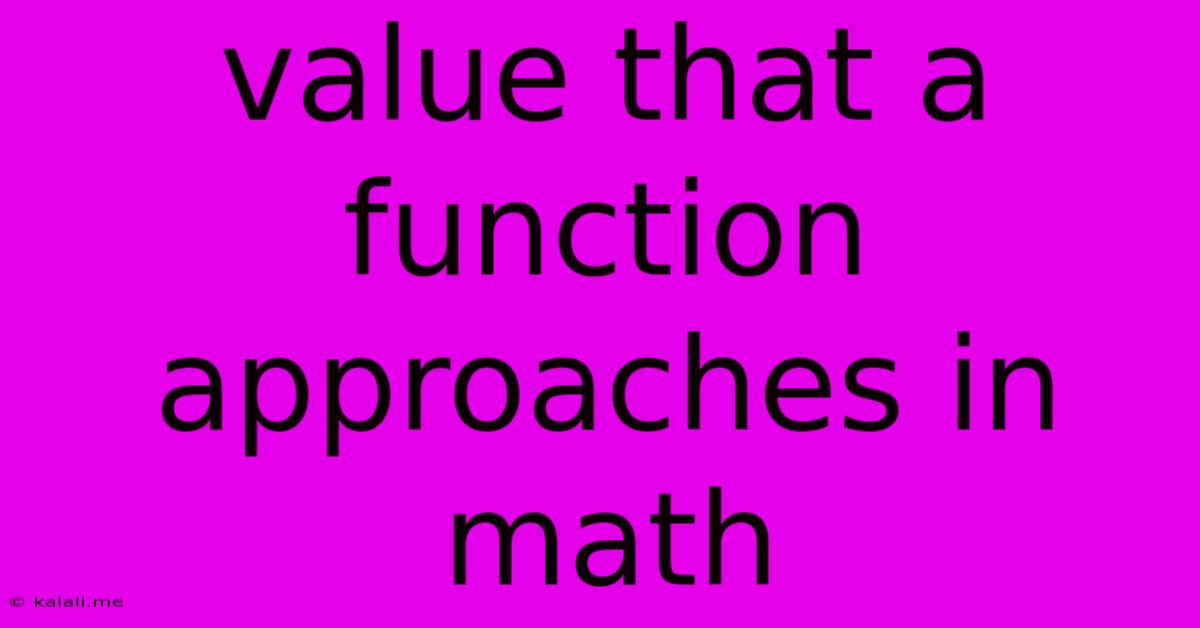Value That A Function Approaches In Math
Kalali
May 24, 2025 · 3 min read

Table of Contents
Understanding Limits: The Value a Function Approaches
This article delves into the concept of limits in mathematics, exploring what it means for a function to approach a particular value. Understanding limits is crucial for calculus and many advanced mathematical concepts. It describes the behavior of a function as its input approaches a specific value, even if the function isn't defined at that exact point.
Limits describe the behavior of a function as the input gets arbitrarily close to a certain value. This is important because sometimes a function may not be defined at a specific point, but we can still determine what value the function is approaching. Think of it like tracing a path on a map – you might not be able to reach the destination (the exact point), but you can still see what the destination looks like by getting closer and closer.
What is a Limit?
Formally, we say that the limit of a function f(x) as x approaches a is L, written as:
lim<sub>x→a</sub> f(x) = L
This means that as x gets arbitrarily close to a (but not necessarily equal to a), the value of f(x) gets arbitrarily close to L. It's crucial to understand that a doesn't need to be in the domain of f(x); the limit only cares about the behavior of the function near a.
Types of Limits
There are several types of limits to consider:
-
One-sided limits: These examine the behavior of a function as x approaches a from either the left (x → a<sup>-</sup>) or the right (x → a<sup>+</sup>). A two-sided limit exists only if both one-sided limits exist and are equal.
-
Infinite limits: These describe situations where the function's value grows without bound as x approaches a. We denote this as lim<sub>x→a</sub> f(x) = ∞ or lim<sub>x→a</sub> f(x) = -∞.
-
Limits at infinity: These explore the behavior of a function as x becomes arbitrarily large (positive or negative infinity). For example, lim<sub>x→∞</sub> f(x) = L indicates that the function approaches L as x grows without bound.
Calculating Limits
Calculating limits can involve various techniques, including:
-
Direct substitution: If the function is continuous at a, you can simply substitute a into the function to find the limit.
-
Algebraic manipulation: Techniques like factoring, simplifying rational expressions, and rationalizing the denominator can be used to transform the function into a form where direct substitution is possible.
-
L'Hôpital's Rule: For indeterminate forms (like 0/0 or ∞/∞), L'Hôpital's Rule allows us to differentiate the numerator and denominator separately and then evaluate the limit of the resulting expression.
-
Graphical analysis: By examining the graph of a function, we can often visually determine the limit as x approaches a specific value.
Importance of Limits
Limits form the foundation of calculus. They are essential for understanding:
-
Derivatives: The derivative of a function at a point is defined as the limit of the difference quotient.
-
Integrals: The definite integral is defined as a limit of Riemann sums.
-
Continuity: A function is continuous at a point if the limit of the function at that point exists and is equal to the function's value at that point.
Understanding limits is not just about finding numerical values; it's about comprehending the behavior of functions and how they approach specific values, providing a crucial link between algebra and the more advanced concepts of calculus. Mastering this concept is vital for success in higher-level mathematics and related fields.
Latest Posts
Latest Posts
-
How Many Cups Are In 3 Quarts Of Water
Jun 30, 2025
-
25 Cents A Minute For An Hour
Jun 30, 2025
-
In Music What Does Allegro Mean Math Answer Key Pdf
Jun 30, 2025
-
What Is 1 5 Of A Tablespoon
Jun 30, 2025
-
How Long Does It Take To Drive Through Illinois
Jun 30, 2025
Related Post
Thank you for visiting our website which covers about Value That A Function Approaches In Math . We hope the information provided has been useful to you. Feel free to contact us if you have any questions or need further assistance. See you next time and don't miss to bookmark.